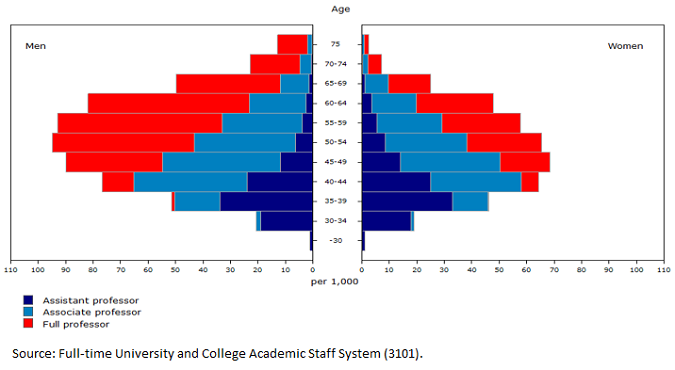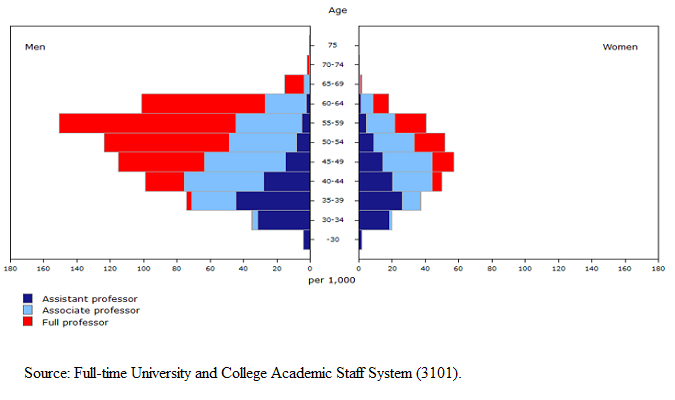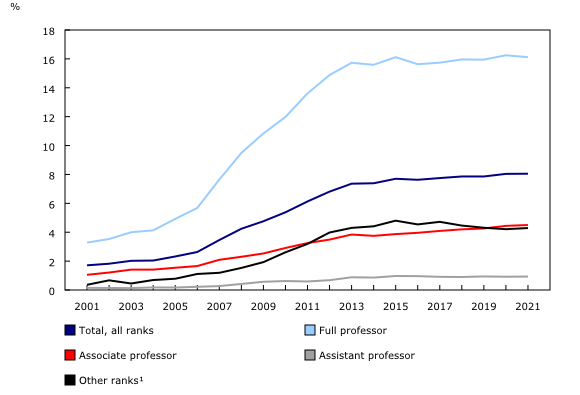Number and salaries of full-time teaching staff at Canadian universities, 2021/2022
Released: 2023-01-23
The median age for full-time academics in Canadian universities has increased by 13 years over the previous five decades, from 38 years in 1971/1972 to 51 years in 2021/2022.
At the same time, women's representation in academia has more than tripled. In 1971/1972, over 1 in 10 academics (12.7%) were women. By 2021/2022, this proportion had increased to over 4 in 10 (42.1%). In 2021/2022, more men are in the cohort of professors nearing retirement age. As this group retires, the share of women may increase further, as they are more represented in the younger cohorts of academics.
Today, Statistics Canada is releasing new data on academic teaching staff from the Full-Time University and College Academic Staff System for the 2021/2022 academic year. This includes information for 111 public degree-granting institutions with 47,799 full-time academic teaching staff in 2021/2022.
Full-time university teaching workforce is aging
As more Canadians approach retirement age, so are full-time academic teaching staff in Canadian universities. Results from the 2021 Census of Population indicated that the working-age population (persons aged 15 to 64 years) has never been older. In May 2021, more than one in five (21.8%) persons of working age were between 55 and 64 years old and were nearing the age normally associated with retirement. In comparison, 27.6% of full-time academic staff in Canadian universities were between 55 and 64 years of age in the 2021/2022 academic year.
Over the previous five decades, there has been a considerable shift in the age distribution of academic staff. In 2021/2022, roughly 1 in 10 (11.5%) full-time teaching staff were aged 65 years and over, compared with 1 in 100 (0.8%) 50 years earlier. This reflects, in part, the aging of the baby boom generation through their academic careers. However, the pace of increase accelerated in the mid-2000s, coinciding with the end of mandatory retirement legislation in most provinces.
Men are overrepresented in older age groups, especially at the full professor rank
Fifty years prior, there were 216 (0.8%) full-time academic staff aged 65 years and over. Of these, 84.7% were men, most of whom were full professors. In 2021/2022, the number of faculty members aged 65 years and over increased to nearly 5,500 (11.5%). In 2021/2022, a large proportion (70.1%) of these faculty members are men. Additionally, in 2021/2022, there were nearly 700 full-time academic teaching staff aged 75 years and over, compared with fewer than 5 in 1971/1972. Of the 700, about 7 in 10 were men at the full professor rank.
In 2021/2022, there were very few (0.4%) teaching faculty members less than 30 years of age, whereas this cohort represented 13.8% of the professoriate in 1971/1972. Following the same trend as the youngest age group, full-time academic staff less than 40 years of age declined from 57.2% in 1971/1972 to 14.8% in 2021/2022. Over time, the job requirements for these positions have changed, and most positions now require a Ph.D. Factoring in the time it takes to obtain this degree potentially increases the age of the population eligible for these positions.
Median age increasing
The median age of full-time academic staff rose from 38 in 1971/1972 to 51 in 2021/2022, a total gain of 13 years. Most of that growth (11 of the 13 years) occurred in the first half of the period, specifically from 1971/1972 to 1994/1995. Meanwhile, in the latter half, since 1995, aging has slowed, with a growth of two years.
While the median age for assistant professors has remained stable at 40 years for the previous decade, it is seven years older than the median age recorded in 1971/1972. Similarly, among associate professors, the median age has been stable at 49 years for the previous decade, an increase of nine years since 1971/1972.
The median age for full professors was 58 in 2021/2022, an increase of 10 years since 1971/1972. The median age for full professors has been stable for the previous five years. Ranks below assistant professor had the most notable increase, from 31 to 48 years, over the 50-year period. An aging faculty may be slowing the promotion of younger academics to higher ranks.
Gender parity at higher ranks is not achieved
Over the previous 50 years, women have increased their representation among full-time academic teaching staff in Canadian universities. In 1971/1972, women represented 12.7% of full-time academic teaching staff. This proportion has increased to 42.1% in 2021/2022, with the majority of these gains occurring in the previous 20 years. In general, there has been a growing share of women in Canada who are economically active. In 2021, 47.8% of the Canadian labour force aged 25 to 54 years were women, compared with 35.4% in 1976 (seasonally unadjusted).
For full-time university teaching staff, the career trajectory is that one generally enters at the assistant professor level and moves through the associate level before becoming a full professor. Within these ranks, the proportion of women is increasing, with women approaching or exceeding parity with their male counterparts for all ranks, except for full professor.
For those at a rank below assistant professor, women attained parity in the early 1990s. Since then, women have slightly outnumbered men. At the assistant professor rank, parity was achieved in 2017/2018, with the proportion of women assistant professors reaching 51.0% in 2021/2022 academic year.
In 2021/2022, the proportion of women associate professors was 44.3%. This is five times greater than in 1971/1972, when women represented 8.7% of associate professors. The gap remains the largest among full professors, as 3 in 10 (31.4%) full professors were women in 2021/2022. Markedly, their representation is almost 10 times higher than in 1971/1972 (3.5%).
Full-time academic staff may also hold senior administrative roles, such as dean, assistant dean, department head or chairperson. Deans typically report to a vice-president of the university and are responsible for a specific academic area, such as a department or college within a university. Similar to the increase in the representation of women who are full professors, the proportion of women deans has risen more than tenfold, from 3.9% in 1971/1972 to 45.3% in 2021/2022.
As the university faculty ages, it will be interesting to examine the impact of retirements on the composition of academic staff. With nearly 5,500 full-time university professors aged 65 years and over and another 6,100 aged 60 to 64 years, nearly one in four (24.2%) is potentially set to leave their job in the coming years.
Note to readers
The Full-time Teaching Staff - University and College Academic Staff System provides Canadians with a detailed portrait of full-time academic staff in Canadian universities. This includes gender, year of birth, principal subject taught, academic rank, salary and administrative stipends, administrative responsibilities, previous employment, and province or country of degrees earned.
Rank or level below assistant professor includes lecturers, instructors and other teaching staff.
Information on part-time teaching staff is currently not in the scope of the data released today. However, Statistics Canada is currently working toward expanding the coverage to include information on these staff.
Products
The interactive data visualization tool "Statistics on full-time academic teaching staff at Canadian universities: Interactive tool" (71-607-X) is available.
Contact information
For more information, or to enquire about the concepts, methods or data quality of this release, contact us (toll-free 1-800-263-1136; 514-283-8300; infostats@statcan.gc.ca) or Media Relations (statcan.mediahotline-ligneinfomedias.statcan@statcan.gc.ca).
- Date modified:






